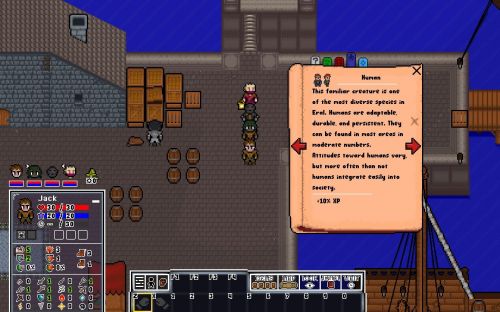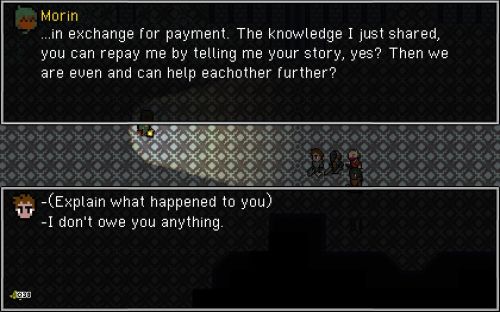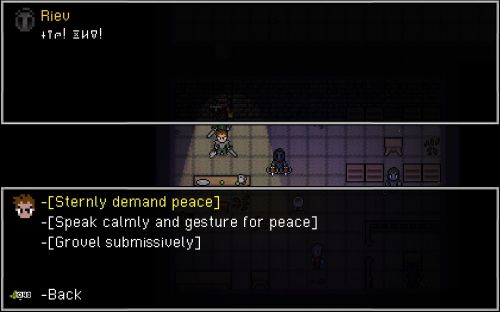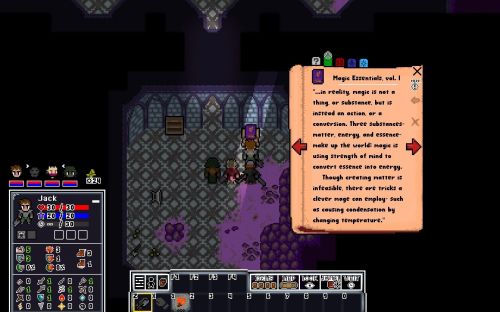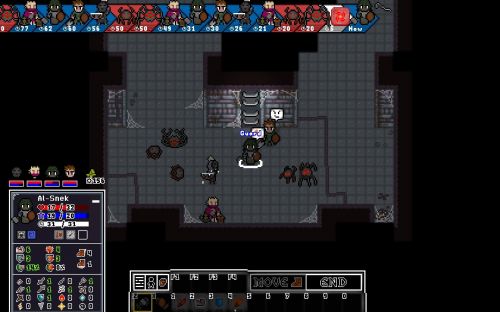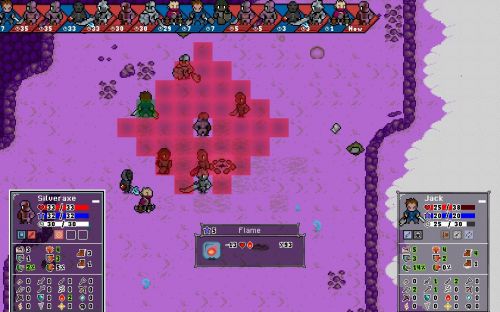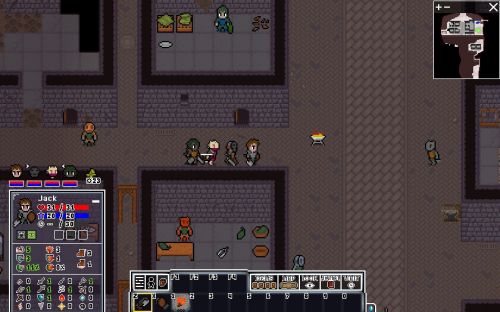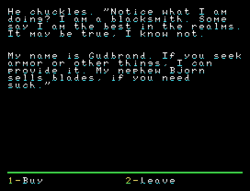[Quickie Nr. 006] Jack Dandy’s catch-up on – Voidspire Tactics
[Quickie Nr. 006] Jack Dandy’s catch-up on – Voidspire Tactics
Review - posted by Crooked Bee on Fri 14 October 2016, 15:12:42
Tags: Quickie; Rad Codex; Voidspire TacticsThanks to Konjad's persistence, "Quickies" have become something of a not-so-proud and not-so-venerable tradition here on the Codex - to the extent that other people submit them now, too. A quickie is essentially a loose and very cursory presentation of a game that the author wants you to try, but is too lazy to do a full review.
This time the game-done-quick is Voidspire Tactics, a niche and not too well-known indie tactical RPG that has been generally favorably received in its dedicated thread on our forums. The write-up belongs to esteemed community member Jack Dandy, who also conducted a brief interview with the developer to complement his piece. Here's an excerpt from the quickie:
And here's one from the interview:
Read the full article: [Quickie Nr. 006] Jack Dandy’s catch-up on – Voidspire Tactics
This time the game-done-quick is Voidspire Tactics, a niche and not too well-known indie tactical RPG that has been generally favorably received in its dedicated thread on our forums. The write-up belongs to esteemed community member Jack Dandy, who also conducted a brief interview with the developer to complement his piece. Here's an excerpt from the quickie:
Now, the most interesting aspect of this is that you can switch your character’s class at any given moment (outside of battle) AND have a Primary and Secondary class. This means that you get to mix and match the skillsets of any 2 classes you have unlocked, PLUS you can combine up to three of any of the Passives your character has unlocked among the different classes.
Customization is the name of the game here. You can make each character really stand out and not risk a penalty for experimentation.
Want to make your guy a standard melee damage dealer? Take a Warrior/Blade.
Want to make a ranger who’s able to fire off a variety of elemental crossbows without reloading once? Take a Sharpshooter/Rogue along with the Scout’s passive “Quick hands” perk.
Want to make a monk who can punch people’s faces just as well as toasting them with a fireball? An Elementalist/Brawler is the way to go.
There are lots of creative ways to build your team, and it’s all done in an intuitive, enjoyable way.
Customization is the name of the game here. You can make each character really stand out and not risk a penalty for experimentation.
Want to make your guy a standard melee damage dealer? Take a Warrior/Blade.
Want to make a ranger who’s able to fire off a variety of elemental crossbows without reloading once? Take a Sharpshooter/Rogue along with the Scout’s passive “Quick hands” perk.
Want to make a monk who can punch people’s faces just as well as toasting them with a fireball? An Elementalist/Brawler is the way to go.
There are lots of creative ways to build your team, and it’s all done in an intuitive, enjoyable way.
And here's one from the interview:
- What inspired you to develop your own game?
My inspiration is basically from playing and enjoying other games - especially games that are really great, but have a handful of small issues. I always want to see what the game would be like without those issues - and the only way to do that is make my own.
Voidspire Tactics in particular was inspired by Final Fantasy Tactics and Ultima VII. I wanted to try to eliminate the weaknesses of each - specifically, FFT's systemic oddities & imbalances, and Ultima VII's uninteresting combat. Dozens of other games had a minor influence as well. Some that come to mind are Zelda (for its exploration), Legend of Mana (its thorough customization), and Dark Souls (its open, you-can-handle-yourself attitude).
My inspiration is basically from playing and enjoying other games - especially games that are really great, but have a handful of small issues. I always want to see what the game would be like without those issues - and the only way to do that is make my own.
Voidspire Tactics in particular was inspired by Final Fantasy Tactics and Ultima VII. I wanted to try to eliminate the weaknesses of each - specifically, FFT's systemic oddities & imbalances, and Ultima VII's uninteresting combat. Dozens of other games had a minor influence as well. Some that come to mind are Zelda (for its exploration), Legend of Mana (its thorough customization), and Dark Souls (its open, you-can-handle-yourself attitude).
Read the full article: [Quickie Nr. 006] Jack Dandy’s catch-up on – Voidspire Tactics
[by Jack Dandy]
Hi! Name’s Jack Dandy. I’m here to catch up on RPGs that received less focus and attention than they deserved. I like giving things a personal edge, so I’ll add a short developer interview to each one.
In the depths of murky 2015, an RPG by the name of Voidspire Tactics was released, to very little fanfare.
Many would blame its basic-looking graphics. Final Fantasy 6 was definitely an “influence”. Some would simply point at the release of other, more highly regarded RPGs - such as The Witcher 3 or (among fans of more obscure games) Underrail.
The game’s main draw: A combination of SRPG-level combat with Zelda-style exploration.
As the type of person who has to fill up each automap to absolute completion in any given game, this was what kept Voidspire Tactics in my sights. Usually, games with good combat end up focusing on that entirely – and vice versa with exploration. To try and achieve both in one game is quite the lofty goal.
Recently, I found the time to actually play through it, so I’ll help you catch up on the game! Skip to the end for a short interview with the developer.
The game’s setting, Eral, is one bereft of usual Tolkien-esque tropes such as grumpy dwarves and haughty elves. In place of these, you get humans, furries, faceless humanoids, snake men, rock men, bug men, and other bipeds that currently slip my mind.
It all starts off with a (player generated) party of 4 adventurers at a nameless harbor, waiting in a bureaucratic line that doesn’t seem to end.
Both the monotony and the harbor are shattered when a strange flash streaks across the sky, the landscape changes drastically, and cruel mercenaries in crimson burst into the scene, killing all in sight.
After dealing with the mercs, you understand that you’re no longer in the proverbial Kansas and set out to find a way out of this mess. What follows is a roughly 20-hour adventure with a distinct beginning and finale, all taking place around and within the titular Voidspire.
The story is self-contained (no out-of-budget cliffhangers here), with a cast of unique, personable NPCs that you’ll get to know and like/hate. A simple chat window is used to converse with the cast – their basic but charming facial expressions help you picture them less as NPCs and more as actual characters.
On top of that, a useful Encyclopedia can help each player find info about the setting itself - you can fill it up with each and every object or creature you click on. From the mundane tree and table to magitech cannons and beasts of legend, each has its own unique description that you can read up on as you progress through the game.
Despite the above, I personally felt that VT laid on a bit too much for the player to really feel invested in the world. A setting like this, built from the ground up, is a very welcome thing, but it begins involving vague concepts and alternate dimensions rather quickly, which I suspect can dilute the whole experience a bit.
On the flip side, these flubs don’t harm the main plot in any way – they merely hint at something far larger than this game is capable of housing. Some might even appreciate its attempt at a “show, don’t tell” style; but that will truly be up to the individual.
Proceeding to the gameplay, Voidspire is based on 3 main pillars: Combat, Classes, and Exploration. As such, I will detail each in a separate section.
The combat in the game is definitely its main selling point.
At the beginning of each encounter, a bar in the upper side of the screen fills up, showing the order in which the combatants will take their turns. Each character can move (within a range governed by the char’s stats), perform an action (attacking/inventory/skills), and change his facing (guys who look the other way are easier to hit). Most of your actions will depend on the characters' classes, which quickly pile up to give you a variety of interesting choices in each and every turn. But I will leave those for the next section.
The combat framework itself is great. Information is clear and apparent to the player, whether it’s your movement range, chance-to-hit, enemy HP, or the meaning of the myriad stats each character is governed by. Quick tooltips bring the player up to speed.
This is the kind of game whose combat lives from encounter to encounter, as the penalties for getting knocked out aren’t too harsh (unless it’s a total party KO, in which case it’s back to main menu!). Each hit usually deals around half or a third of a character’s HP – you must think on your feet at each turn, especially as no trash mobs are to be found here either. The challenge in this game isn’t in surviving a long gauntlet of samey encounters, but making it out of the current one safe & sound.
As mentioned before, you start the game by generating a party of 4 characters. The customization is great and LARPers will have a field day when adjusting clothing styles and individual facial features.
Thankfully, it’s no slouch in the mechanics department either. There are 4 races (with 2 more in New Game+) and 3 initial “Warrior-Mage-Rogue” type classes. Each class encompasses its own XP bar and a set of 7 Active + 3 Passive skills. In addition, your choice of class affects your characters' stats (such as movement range, weapon proficiency, and so on).
The neat thing about this is that you can unlock up to 18 new classes. For example, to unlock the tanky Guardian class, you need to amass a total of 450 XP with the Warrior class by having it as your Primary one.
In a spark of design ingenuity, the class unlocks only count the total XP you've EARNED, so the player doesn’t need to worry about whether he should use his XP to improve more skills from the current class or save it to unlock a new one. Fiddling around with this system is a joy, and the classes get pretty interesting – samurai style Blades, elemental Sorcerers, hand-to-hand Brawlers, turret-laying Mechanists, Unmakers who dabble in dark magicks, and more.
Now, the most interesting aspect of this is that you can switch your character’s class at any given moment (outside of battle) AND have a Primary and Secondary class. This means that you get to mix and match the skillsets of any 2 classes you have unlocked, PLUS you can combine up to three of any of the Passives your character has unlocked among the different classes.
Customization is the name of the game here. You can make each character really stand out and not risk a penalty for experimentation.
Want to make your guy a standard melee damage dealer? Take a Warrior/Blade.
Want to make a ranger who’s able to fire off a variety of elemental crossbows without reloading once? Take a Sharpshooter/Rogue along with the Scout’s passive “Quick hands” perk.
Want to make a monk who can punch people’s faces just as well as toasting them with a fireball? An Elementalist/Brawler is the way to go.
There are lots of creative ways to build your team, and it’s all done in an intuitive, enjoyable way.
The third pillar of the game, and one that really makes it stand out.
Between each combat, you get to explore the Voidspire, seeking out its various dungeons, mazes and towns. In towns you might do the generic RPG things – chatting with vendors, getting rumors, raiding closets...
Exploration gets more interesting than this, though.
Remember the skills I mentioned earlier? You can use them outside of combat as well – use fire magic to burn down a patch of grass and find a hidden entrance to a dungeon, or ice magic to freeze a lake and cross it safely. Items also have a role in exploring the world - use shovels to dig up secrets, spikes and ropes to climb down mountainsides, and more. A good variety of these tricks help make the world feel interactive and enticing, while also encouraging players to explore and try new things with the gameworld instead of treating it as a static backdrop.
Speaking of backdrops, the game’s multiverse setting allows for a very interesting variety of areas to explore, switching typical “town-lava-ice-jungle” fantasy stages for weird places such as a lake of wine, a robot graveyard, or plains of semi-organic rock formations.
As for inventory and crafting, the game uses an old-school approach to these. Each character has his own “bag” in which you can store things (or additional bags, packrats may rejoice). You can also “craft” items if you so desire, but this kind of thing is done in a more intuitive fashion. More Ultima VII-like, so to speak. For example, you can carry around a pair of shears and then use them on any piece of cloth you find - a quick and handy way to produce bandages. The old bottle-rag-oil Molotov surprise works just fine, too.
These two areas of the game are less impressive, but (and this is important): They WORK. And they work well.
The sound effects are all basic, but none of them are annoying, or repetitive. The music ranges from mediocre, through moody, to catchy – I suspect this is due to the game's soundtrack having multiple composers. One thing has to be mentioned, though: the vast majority of combat tracks are absolutely great, which is a good thing, considering the time you’ll spend duking it out with whatever the Voidspire throws at you.
The graphics themselves are not impressive. The backgrounds are drab, and a quick glance at the character sprites might make you think of RPGmaker at best, and crude edits of Final Fantasy 6’s cast at worst. However, as you progress through the game, you’ll note all kinds of enjoyable details - the smoothness of the combat animations, the characters’ facial expressions, areas burning away during a battle between fire-slinging mages, characters panting & kneeling as their HP nears 0...
I found that all these touches more than made up for the basic-looking appearance of the game. But you’ll have to play it to see what I mean.
All and all, I can safely recommend the game to anyone who has an interest in SRPGs. The combat could definitely carry the game on its own, but the addition of exploration and plenty of personal touches boosts it up into something much more interesting. The game’s somewhat short length might put some folks off, but you have to consider that its 20 hours are all quality, no grind.
So? Feeling caught up yet? In case you aren’t, here’s a little chat I had with the developer.
- Hi there! I’ll start off with this: what goals did you try to achieve with the game? Was there a specific niche you wanted to reach?
Voidspire Tactics was mainly created by the desire to see more Tactics RPGs as mechanically deep as Final Fantasy Tactics. I've almost never encountered TRPGs that can match FFT's excellent Job and combat system. I also wanted to improve on certain aspects of FFT, such as the awkward way in which you must grind for Job Points, or the way some classes are strictly inferior to others.
I know there must be other people like me, obsessively checking out every game with a title that ends in 'Tactics', looking for the same depth and customization. Those people are the niche I wanted to tackle.
- What inspired you to develop your own game?
My inspiration is basically from playing and enjoying other games - especially games that are really great, but have a handful of small issues. I always want to see what the game would be like without those issues - and the only way to do that is make my own.
Voidspire Tactics in particular was inspired by Final Fantasy Tactics and Ultima VII. I wanted to try to eliminate the weaknesses of each - specifically, FFT's systemic oddities & imbalances, and Ultima VII's uninteresting combat. Dozens of other games had a minor influence as well. Some that come to mind are Zelda (for its exploration), Legend of Mana (its thorough customization), and Dark Souls (its open, you-can-handle-yourself attitude).
- Are there things you feel you could have done better with VT?
Definitely. Graphics are the big, obvious one. While I am proud of the character sprites and combat animations, the environmental art is lacking. I simply didn't have time to create the kind of varied and detailed sprites needed for all the big, diverse areas. I also made some atrocious palette choices. (Some of the water is pure mini-golf-course levels of blue.)
Another thing that could have used more work is the story. It's not 'bad', but it's barebones. Again, it came down to time - I had to limit the number of events and characters, so the plot couldn't get too complicated. Some might view that as a positive aspect, though.
There's a lot of other little things like certain interface and mechanical issues that I'm not happy with, but aren't very important. I'm hoping to resolve those in my next game.
- What will you focus on in the sequel?
Technically it isn't a 'sequel', but it's close enough. I'll be revisiting the same world and game engine, but with some fairly large changes.
I want my next game to feature a larger player party (max 6 characters instead of 4) as well as being able to recruit a small army to build your party from. I'm combining this with some roguelite elements - for example, the core gameplay will be taking a squad through a 'dungeon' (not a literal castle dungeon). Certain areas will be procedurally generated. Characters can die permanently - and there are ways to safeguard against that.
I'm also focused on making the NPCs more interesting. In Voidspire, all but 5 or 6 characters were basically incidental - and even those 5 or 6 play a small role. In the next game I have a number of characters that will assist you and provide advice (when asked for!) throughout. Hopefully they can be more of a presence and have an interesting personality that shines through, rather than feeling like questgivers.
- Any final words of your own for whomever is on the fence about purchasing VT?
Whether you're looking for deep tactical combat, or lots of exploration and secrets, please give Voidspire Tactics a try! For all my talk about Tactics, I know a lot of people who don't care for complex battle systems but really enjoyed Voidspire. And if tactical combat is your thing (like it is mine), then definitely check it out!
Voidspire Tactics is available on Steam or DRM-free directly from the developer.
Hi! Name’s Jack Dandy. I’m here to catch up on RPGs that received less focus and attention than they deserved. I like giving things a personal edge, so I’ll add a short developer interview to each one.
In the depths of murky 2015, an RPG by the name of Voidspire Tactics was released, to very little fanfare.
Many would blame its basic-looking graphics. Final Fantasy 6 was definitely an “influence”. Some would simply point at the release of other, more highly regarded RPGs - such as The Witcher 3 or (among fans of more obscure games) Underrail.
The game’s main draw: A combination of SRPG-level combat with Zelda-style exploration.
As the type of person who has to fill up each automap to absolute completion in any given game, this was what kept Voidspire Tactics in my sights. Usually, games with good combat end up focusing on that entirely – and vice versa with exploration. To try and achieve both in one game is quite the lofty goal.
Recently, I found the time to actually play through it, so I’ll help you catch up on the game! Skip to the end for a short interview with the developer.
Story:
The game’s setting, Eral, is one bereft of usual Tolkien-esque tropes such as grumpy dwarves and haughty elves. In place of these, you get humans, furries, faceless humanoids, snake men, rock men, bug men, and other bipeds that currently slip my mind.
It all starts off with a (player generated) party of 4 adventurers at a nameless harbor, waiting in a bureaucratic line that doesn’t seem to end.
Both the monotony and the harbor are shattered when a strange flash streaks across the sky, the landscape changes drastically, and cruel mercenaries in crimson burst into the scene, killing all in sight.
After dealing with the mercs, you understand that you’re no longer in the proverbial Kansas and set out to find a way out of this mess. What follows is a roughly 20-hour adventure with a distinct beginning and finale, all taking place around and within the titular Voidspire.
The story is self-contained (no out-of-budget cliffhangers here), with a cast of unique, personable NPCs that you’ll get to know and like/hate. A simple chat window is used to converse with the cast – their basic but charming facial expressions help you picture them less as NPCs and more as actual characters.
On top of that, a useful Encyclopedia can help each player find info about the setting itself - you can fill it up with each and every object or creature you click on. From the mundane tree and table to magitech cannons and beasts of legend, each has its own unique description that you can read up on as you progress through the game.
Despite the above, I personally felt that VT laid on a bit too much for the player to really feel invested in the world. A setting like this, built from the ground up, is a very welcome thing, but it begins involving vague concepts and alternate dimensions rather quickly, which I suspect can dilute the whole experience a bit.
On the flip side, these flubs don’t harm the main plot in any way – they merely hint at something far larger than this game is capable of housing. Some might even appreciate its attempt at a “show, don’t tell” style; but that will truly be up to the individual.
Proceeding to the gameplay, Voidspire is based on 3 main pillars: Combat, Classes, and Exploration. As such, I will detail each in a separate section.
Combat:
The combat in the game is definitely its main selling point.
At the beginning of each encounter, a bar in the upper side of the screen fills up, showing the order in which the combatants will take their turns. Each character can move (within a range governed by the char’s stats), perform an action (attacking/inventory/skills), and change his facing (guys who look the other way are easier to hit). Most of your actions will depend on the characters' classes, which quickly pile up to give you a variety of interesting choices in each and every turn. But I will leave those for the next section.
The combat framework itself is great. Information is clear and apparent to the player, whether it’s your movement range, chance-to-hit, enemy HP, or the meaning of the myriad stats each character is governed by. Quick tooltips bring the player up to speed.
This is the kind of game whose combat lives from encounter to encounter, as the penalties for getting knocked out aren’t too harsh (unless it’s a total party KO, in which case it’s back to main menu!). Each hit usually deals around half or a third of a character’s HP – you must think on your feet at each turn, especially as no trash mobs are to be found here either. The challenge in this game isn’t in surviving a long gauntlet of samey encounters, but making it out of the current one safe & sound.
Character customization:
As mentioned before, you start the game by generating a party of 4 characters. The customization is great and LARPers will have a field day when adjusting clothing styles and individual facial features.
Thankfully, it’s no slouch in the mechanics department either. There are 4 races (with 2 more in New Game+) and 3 initial “Warrior-Mage-Rogue” type classes. Each class encompasses its own XP bar and a set of 7 Active + 3 Passive skills. In addition, your choice of class affects your characters' stats (such as movement range, weapon proficiency, and so on).
The neat thing about this is that you can unlock up to 18 new classes. For example, to unlock the tanky Guardian class, you need to amass a total of 450 XP with the Warrior class by having it as your Primary one.
In a spark of design ingenuity, the class unlocks only count the total XP you've EARNED, so the player doesn’t need to worry about whether he should use his XP to improve more skills from the current class or save it to unlock a new one. Fiddling around with this system is a joy, and the classes get pretty interesting – samurai style Blades, elemental Sorcerers, hand-to-hand Brawlers, turret-laying Mechanists, Unmakers who dabble in dark magicks, and more.
Now, the most interesting aspect of this is that you can switch your character’s class at any given moment (outside of battle) AND have a Primary and Secondary class. This means that you get to mix and match the skillsets of any 2 classes you have unlocked, PLUS you can combine up to three of any of the Passives your character has unlocked among the different classes.
Customization is the name of the game here. You can make each character really stand out and not risk a penalty for experimentation.
Want to make your guy a standard melee damage dealer? Take a Warrior/Blade.
Want to make a ranger who’s able to fire off a variety of elemental crossbows without reloading once? Take a Sharpshooter/Rogue along with the Scout’s passive “Quick hands” perk.
Want to make a monk who can punch people’s faces just as well as toasting them with a fireball? An Elementalist/Brawler is the way to go.
There are lots of creative ways to build your team, and it’s all done in an intuitive, enjoyable way.
Exploration:
The third pillar of the game, and one that really makes it stand out.
Between each combat, you get to explore the Voidspire, seeking out its various dungeons, mazes and towns. In towns you might do the generic RPG things – chatting with vendors, getting rumors, raiding closets...
Exploration gets more interesting than this, though.
Remember the skills I mentioned earlier? You can use them outside of combat as well – use fire magic to burn down a patch of grass and find a hidden entrance to a dungeon, or ice magic to freeze a lake and cross it safely. Items also have a role in exploring the world - use shovels to dig up secrets, spikes and ropes to climb down mountainsides, and more. A good variety of these tricks help make the world feel interactive and enticing, while also encouraging players to explore and try new things with the gameworld instead of treating it as a static backdrop.
Speaking of backdrops, the game’s multiverse setting allows for a very interesting variety of areas to explore, switching typical “town-lava-ice-jungle” fantasy stages for weird places such as a lake of wine, a robot graveyard, or plains of semi-organic rock formations.
As for inventory and crafting, the game uses an old-school approach to these. Each character has his own “bag” in which you can store things (or additional bags, packrats may rejoice). You can also “craft” items if you so desire, but this kind of thing is done in a more intuitive fashion. More Ultima VII-like, so to speak. For example, you can carry around a pair of shears and then use them on any piece of cloth you find - a quick and handy way to produce bandages. The old bottle-rag-oil Molotov surprise works just fine, too.
Sound & Graphics:
These two areas of the game are less impressive, but (and this is important): They WORK. And they work well.
The sound effects are all basic, but none of them are annoying, or repetitive. The music ranges from mediocre, through moody, to catchy – I suspect this is due to the game's soundtrack having multiple composers. One thing has to be mentioned, though: the vast majority of combat tracks are absolutely great, which is a good thing, considering the time you’ll spend duking it out with whatever the Voidspire throws at you.
The graphics themselves are not impressive. The backgrounds are drab, and a quick glance at the character sprites might make you think of RPGmaker at best, and crude edits of Final Fantasy 6’s cast at worst. However, as you progress through the game, you’ll note all kinds of enjoyable details - the smoothness of the combat animations, the characters’ facial expressions, areas burning away during a battle between fire-slinging mages, characters panting & kneeling as their HP nears 0...
I found that all these touches more than made up for the basic-looking appearance of the game. But you’ll have to play it to see what I mean.
And to sum it all up:
All and all, I can safely recommend the game to anyone who has an interest in SRPGs. The combat could definitely carry the game on its own, but the addition of exploration and plenty of personal touches boosts it up into something much more interesting. The game’s somewhat short length might put some folks off, but you have to consider that its 20 hours are all quality, no grind.
So? Feeling caught up yet? In case you aren’t, here’s a little chat I had with the developer.
Interview with Eldiran, developer of Voidspire Tactics:
- Hi there! I’ll start off with this: what goals did you try to achieve with the game? Was there a specific niche you wanted to reach?
Voidspire Tactics was mainly created by the desire to see more Tactics RPGs as mechanically deep as Final Fantasy Tactics. I've almost never encountered TRPGs that can match FFT's excellent Job and combat system. I also wanted to improve on certain aspects of FFT, such as the awkward way in which you must grind for Job Points, or the way some classes are strictly inferior to others.
I know there must be other people like me, obsessively checking out every game with a title that ends in 'Tactics', looking for the same depth and customization. Those people are the niche I wanted to tackle.
- What inspired you to develop your own game?
My inspiration is basically from playing and enjoying other games - especially games that are really great, but have a handful of small issues. I always want to see what the game would be like without those issues - and the only way to do that is make my own.
Voidspire Tactics in particular was inspired by Final Fantasy Tactics and Ultima VII. I wanted to try to eliminate the weaknesses of each - specifically, FFT's systemic oddities & imbalances, and Ultima VII's uninteresting combat. Dozens of other games had a minor influence as well. Some that come to mind are Zelda (for its exploration), Legend of Mana (its thorough customization), and Dark Souls (its open, you-can-handle-yourself attitude).
- Are there things you feel you could have done better with VT?
Definitely. Graphics are the big, obvious one. While I am proud of the character sprites and combat animations, the environmental art is lacking. I simply didn't have time to create the kind of varied and detailed sprites needed for all the big, diverse areas. I also made some atrocious palette choices. (Some of the water is pure mini-golf-course levels of blue.)
Another thing that could have used more work is the story. It's not 'bad', but it's barebones. Again, it came down to time - I had to limit the number of events and characters, so the plot couldn't get too complicated. Some might view that as a positive aspect, though.
There's a lot of other little things like certain interface and mechanical issues that I'm not happy with, but aren't very important. I'm hoping to resolve those in my next game.
- What will you focus on in the sequel?
Technically it isn't a 'sequel', but it's close enough. I'll be revisiting the same world and game engine, but with some fairly large changes.
I want my next game to feature a larger player party (max 6 characters instead of 4) as well as being able to recruit a small army to build your party from. I'm combining this with some roguelite elements - for example, the core gameplay will be taking a squad through a 'dungeon' (not a literal castle dungeon). Certain areas will be procedurally generated. Characters can die permanently - and there are ways to safeguard against that.
I'm also focused on making the NPCs more interesting. In Voidspire, all but 5 or 6 characters were basically incidental - and even those 5 or 6 play a small role. In the next game I have a number of characters that will assist you and provide advice (when asked for!) throughout. Hopefully they can be more of a presence and have an interesting personality that shines through, rather than feeling like questgivers.
- Any final words of your own for whomever is on the fence about purchasing VT?
Whether you're looking for deep tactical combat, or lots of exploration and secrets, please give Voidspire Tactics a try! For all my talk about Tactics, I know a lot of people who don't care for complex battle systems but really enjoyed Voidspire. And if tactical combat is your thing (like it is mine), then definitely check it out!
Voidspire Tactics is available on Steam or DRM-free directly from the developer.
There are 9 comments on [Quickie Nr. 006] Jack Dandy’s catch-up on – Voidspire Tactics




